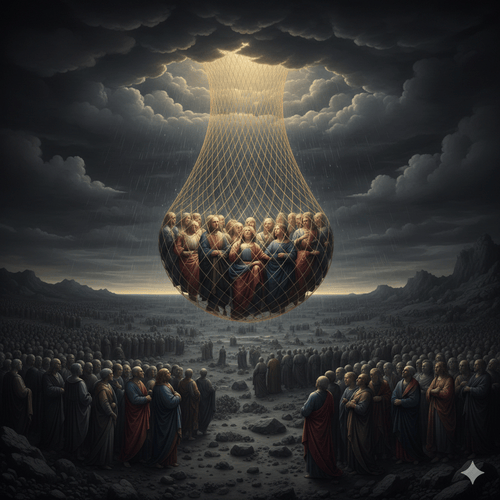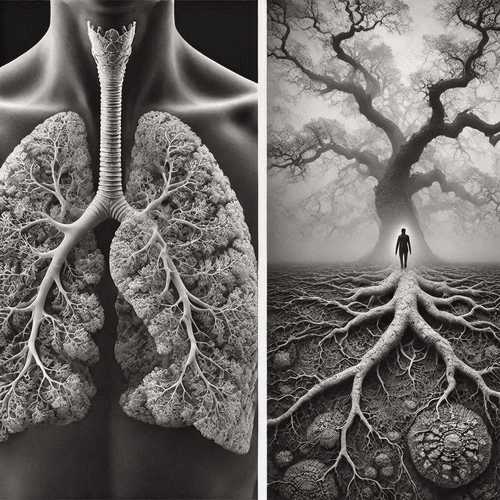Patterns In Chaos: How Fractals Scream Intelligent Design
In the beginning, God created the heavens and the earth, bringing order from chaos. Today, mathematical patterns known as fractals reveal this divine ordering principle continuing throughout creation, from the smallest bronchial branch to the mightiest galaxy. While some see randomness in nature’s complexity, a deeper look reveals an intricate blueprint that points unmistakably to an intelligent designer.
UNDERSTANDING FRACTALS
Definition and Properties Fractals are complex geometric shapes that can be split into parts, each of which is a smaller copy of the whole. This property is known as self-similarity. Unlike traditional geometric shapes, fractals have intricate, infinite patterns that repeat at every scale. (TO LEARN MORE, CHECK OUT OUR POST: The Mandelbrot Set: Surprising Evidence for Intelligent Design)
Varieties of Fractals While the Mandelbrot Set is one of the most famous examples, fractals come in many forms:
- Julia Sets: Similar to the Mandelbrot Set, but each point is generated using a different initial value.
- Natural Fractals: Examples include the branching patterns of trees, the intricate structure of snowflakes, and the jagged outlines of coastlines.
THE HIDDEN ORDER IN LIVING SYSTEMS
The Human Body: A Testament to Divine Engineering
Fractals Scream Intelligent Design: Deep within the human body lies an astonishing testament to God’s mathematical genius. Our lungs branch into increasingly smaller airways, forming a fractal pattern that maximises oxygen absorption while minimising the space required. This same divine efficiency appears in our circulatory system, where blood vessels branch in fractal networks that ensure every cell receives necessary nutrients. Even our neural pathways exhibit this sacred geometry, allowing complex information processing in a compact space.
Consider the implications: these fractal patterns solve complex engineering challenges with elegant efficiency. The bronchial tree’s fractal structure, for instance, packs a surface area equivalent to a tennis court into the small space of our chest cavity. Such optimisation speaks not of random chance, but of purposeful design.
The Plant Kingdom: God’s Geometric Canvas
Step into any garden, and you’ll find yourself surrounded by divine fractals. Look closely at a leaf’s venation pattern—the way its veins branch progressively smaller to deliver nutrients to every cell. This isn’t random; it’s a precisely calculated distribution system that ensures maximum efficiency with minimal energy expenditure.
Root systems tell a similar story, extending in fractal patterns that optimise water and nutrient absorption. Tree branches follow fractal rules that maximise sunlight exposure while also maintaining structural integrity. These patterns appear across countless plant species, suggesting a common designer rather than coincidence.
EARTH’S PHYSICAL SYSTEMS: THE CANVAS OF CREATION
- Weather Patterns: Order in the Atmosphere: Modern meteorological research reveals fractal patterns in atmospheric phenomena that defy evolutionary explanation. Cloud formations follow fractal principles at multiple scales, from individual clouds to global weather systems. Hurricane structures display remarkable spiral patterns that optimise energy distribution—another example of mathematical precision in supposedly chaotic systems.
- Geological Symphony: From mountain ranges to river deltas, Earth’s geological features bear the hallmark of fractal design. Recent geological studies have documented how coastlines exhibit consistent fractal dimensions, suggesting an underlying order to their apparent randomness. River networks branch in patterns that optimise water distribution across vast territories, displaying an efficiency that points to intentional design rather than chance development.
MATHEMATICAL IMPROBABILITY: BEYOND COINCIDENCE
The Numbers Speak
Statistical analysis reveals the astronomical improbability of such complex fractal patterns arising by chance. Recent mathematical research demonstrates the precise optimisation in natural fractals requires an intelligence capable of complex calculations. The probability of these patterns emerging randomly is vanishingly small, challenging purely naturalistic explanations.
Information Theory: The Language of Design
Fractals Scream Intelligent Design: Modern information theory provides compelling evidence for intelligent design in fractal patterns. The presence of complex specified information in natural fractals—patterns that are both complex and functional—strongly suggests programming rather than random processes. Recent developments in information theory have only strengthened this connection between fractal patterns and intelligent design.
THEOLOGICAL SIGNIFICANCE: THE DIVINE MATHEMATICIAN
Biblical Wisdom: Scripture repeatedly emphasises God’s role as the master designer who brings order from chaos. Genesis 1:1 introduces God as the creator who imposed order on formless void. Throughout the Bible, we find references to God’s mathematical nature—from the precise measurements of the Temple to the ordered patterns of creation.
Divine Philosophy: The presence of mathematical beauty in nature points to a creator who values both function and aesthetics. These fractal patterns serve as a divine signature, revealing a God who delights in mathematical elegance while ensuring practical efficiency. Recent theological discourse has increasingly recognised mathematics as a divine language through which God reveals His nature.
CONCLUSION: A CALL TO WONDER
The fractal patterns woven throughout creation reveal a designer of unparalleled intelligence and creativity. From the intricate architecture of our bodies to the grand designs of weather systems, we see evidence of purpose, planning, and precision. This mathematical testimony challenges us to look beyond surface chaos to recognize the divine order that underlies all creation.
Fractals Scream Intelligent Design—Related FAQs
Can fractal patterns help us predict natural disasters? Scientists are increasingly using fractal analysis to study earthquake patterns, landslide risks, and extreme weather events. The fractal properties of fault lines and tectonic movements can help identify areas of heightened seismic risk. Similarly, fractal analysis of weather patterns has improved our ability to predict the formation and behaviour of severe storms, though it’s important to note these systems still maintain an element of divine sovereignty that prevents perfect prediction.
- How are fractals being used in modern medicine? Medical researchers are applying fractal geometry to develop more effective drug delivery systems that mimic the body’s natural distribution networks. Fractal patterns have also revolutionised medical imaging, helping doctors better distinguish between healthy and cancerous tissue based on their different fractal dimensions. Additionally, understanding the fractal nature of heartbeat patterns has led to improved methods for detecting cardiac abnormalities, demonstrating how God’s mathematical design principles can guide medical innovations.
- Why don’t artificial fractals look exactly like natural ones? Natural fractals, designed by God, typically show 5-8 levels of self-similarity before reaching their physical limits, while computer-generated fractals can continue infinitely. This difference reflects the practical constraints of physical matter versus pure mathematics, similar to how a real tree cannot branch infinitely like its mathematical model. The beauty of natural fractals lies in their optimal balance between mathematical ideals and physical functionality.
- Can animals recognise fractal patterns? Research suggests many animals are naturally attuned to fractal patterns, with studies showing creatures from birds to bees use fractal-based navigation in natural environments. This innate recognition appears to be divinely programmed into their neural systems, helping them find food, build homes, and navigate efficiently. Interestingly, even human beings show a natural preference for fractal patterns with specific dimensional ranges, suggesting a created predisposition to recognise divine order.
How do fractals relate to sound and music? The mathematical structure of many classical musical compositions exhibits fractal-like patterns, particularly in works by Bach and Mozart. Natural sounds, from bird songs to ocean waves, often display fractal properties in their wave patterns and rhythms. This musical mathematics suggests God embedded fractal harmony not just in what we see, but in what we hear, creating a multi-sensory testimony to divine design.
- Are there fractal patterns in human behaviour and social systems? Social scientists have discovered fractal patterns in human population distribution, internet network structures, and even financial market behaviours. Cities grow in fractal-like patterns that remarkably resemble natural branching systems, suggesting divine principles at work even in human social organisation. These patterns emerge despite human free will, pointing to an underlying created order in social systems.
- How can understanding fractals improve technology? Engineers are increasingly using fractal designs to create more efficient antennas, stronger building materials, and better computer networks. Fractal-based technologies often prove more resilient and adaptable than traditional designs, demonstrating the practical superiority of divine architectural principles. Many of these innovations draw direct inspiration from natural fractal patterns, effectively “reverse engineering” God’s created designs.
- Can fractal patterns help us understand aging and longevity? Recent research has revealed the degradation of fractal patterns in human physiological systems may be a key indicator of aging. For example, our heartbeat patterns become less fractal-like as we age, and similar changes occur in our neural pathways and blood vessels. This loss of fractal complexity may explain why aging bodies become less adaptive and resilient—suggesting God designed these mathematical patterns as essential components of youthful health and vitality.
- How do fractals relate to human language and communication? Linguistic analysis has uncovered fractal patterns in human language structure, from the organisation of letters and words to the construction of sentences and paragraphs. These patterns appear across different languages and cultures, suggesting a divinely ordained mathematical foundation to human communication. Interestingly, studies show texts authored by individuals with certain neurological conditions often deviate from these natural fractal patterns. This indicates our Creator embedded these mathematical principles deep within our cognitive architecture.
Why do some artists and architects intentionally avoid fractal patterns? While most traditional and classical architecture incorporates fractal elements that mirror natural design, some modern movements deliberately reject these patterns in favour of simple geometric forms. This departure from natural fractal principles often results in environments that people find subconsciously stressful or uncomfortable, as evidenced by psychological studies measuring responses to different architectural styles. This phenomenon supports the idea that our Creator designed us to thrive in environments that reflect His mathematical order.
Fractals Scream Intelligent Design—Our Related Posts
- The Mandelbrot Set: Surprising Evidence for Intelligent Design
- Sacred Symmetry: How Fibonacci Numbers Reveal God’s Design
- Does Math Reveal the Mind of God? The Divine Design in Numbers
- The God Equation: Quantum Physics and the Evidence for Design
Editor's Pick

Why Do People Hate the Doctrine of Election?
…WHEN THEY REALLY SHOULDN’T Few Bible doctrines provoke stronger reactions than election. The idea that God chose some for salvation [...]

The Doctrine of Providence: Does God Really Govern All Things?
You’re sitting in the doctor’s office when the diagnosis lands like a thunderclap. Your mind races: Why this? Why now? [...]

No Decay, No Defeat: What It Means That Christ’s Body Saw No Corruption
On the Day of Pentecost, Peter stood before thousands and made a startling claim: David's body decayed in the tomb, [...]
SUPPORT US:
Feel the Holy Spirit's gentle nudge to partner with us?
Donate Online:
Account Name: TRUTHS TO DIE FOR FOUNDATION
Account Number: 10243565459
Bank IFSC: IDFB0043391
Bank Name: IDFC FIRST BANK






